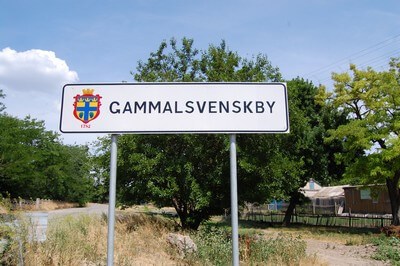
Gammalsvenskby - Gammal svensk by - "Old Swedish Village". A hundred kilometres upstream from where the muddy Dnepr eventually reaches the Black Sea lies Gammalsvenskby, an unlikely outpost of Scandinavian manners in a remote agricultural region that is well off the usual tourist trails. It is a region that people pass through on the way from Kyjiv to the Crimea; occasionally a Swedish tour group will stop off, bemused to find a place in this foreign land with hints of home. Kherson Oblast is another world from Stockholm.
Since sometime during the 14th century, a Swedish population had lived on the island Hiiumaa (sw: Dagö ) in present day’s Estonia. In 1781, the Russian empress Catherine the Great decided that they had to be moved. With a combination of threats and promises, she made the population walk the long way (more then 1000 km) to the village Zmejevka north of the Black Sea.
In 1929, the church was closed by the Soviet government. Life in the Soviet Union turned out to be hard. The famine of 1932–1933 renewed interest in the idea of returning to Sweden – some villagers signed a list stating that they wanted to leave the country. This led to the arrest of 20 people by the secret police, the GPU. Five of them were sent to prison. Several villagers were killed in the Stalinist purge of the following years. In 1930s, the majority of the 3,500 Scandinavian descendants who lived in the Southern Ukraine were accused of spying and sent along with their families to katorga in Siberia and Karelia.
After the fall of the Soviet Union, contacts with Sweden and Canada were re-established, and the Church of Sweden and Gotland Municipality lent economic support. In 1996, Chumak, a Swedish-owned producer of oil, ketchup and canned food, was established in the nearby town of Kakhovka. Today, the village has only around 108 people who share a Swedish cultural heritage. Only a few of them still speak the Old-Swedish dialect fluently and German is often used instead.
The people of Gammalsvenskby maintained their traditions, their Lutheran (Church of Sweden) faith, and their old Swedish dialect. At the end of the 19th century, some ties with Sweden were re-established. Considerable funds were raised in Sweden and Finland to build a new Swedish church (a previous wooden church given by Prince Potemkin burned in the mid-19th century). The resulting parish church of St John was opened in 1885. For a time, before the revolutions following World War I, visits from Sweden became frequent, and some villagers subscribed to Swedish newspapers.
Старошведське (Wikipedia)
Video from Gammalsvenskby (English - Youtube)
Video from Gammalsvenskby (In swedish - YouTube)
Source: Wikipedia

Comments powered by CComment